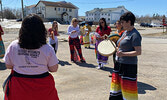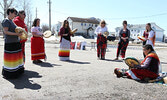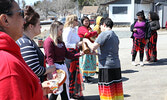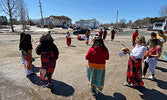Red Dress Day commemorated in Sioux Lookout
Tim Brody - Editor
Community members and organizations commemorated Red Dress Day in Sioux Lookout on May 5.
The day raises awareness of Missing and Murdered Indigenous Women and Girls (MMIWG).
Outside the Sunset Women’s Aboriginal Circle (SWAC) office, Romaine Lyon, Elder for SWAC, led participants in smudging, prayer, a water ceremony and a round dance.
She said of SWAC and other local organizations marking the day, “I think that it’s a positive move towards, I guess you’d have to say, reconciliation and acknowledging what the Anishinaabe has been through.”
Treena Ashmugeesha is the Indigenous Prenatal and Postnatal Support Worker at SWAC.
She said of SWAC hosting a Red Dress Day event, “I think my main idea was just to get people together to raise awareness about MMIWG and to recognize that it’s a very real issue. A lot of times when we hear and see these things on the news it’s other parts of the country or it’s in the states, or somewhere else, but it’s a very real issue for our own community. There’s missing and murdered Indigenous women from my reserve of Mishkeegogamang. There’s women that have gone missing from here in Sioux Lookout and there’s unsolved cases and things like that. Days like this are there to remind people, remind community members, Indigenous and non-Indigenous, that these are very real issues that we face all the time. There’s still families alive today that are missing their family members and wondering where they are, wondering what happened to them, looking for answers. I think days like this are very important to bring that back up and remind people that it’s still happening, it’s a very big issue.”
Ashmugeesha wore a shirt that day depicting Sarah Skunk, who has been missing since 1995. “She is a great aunt of my oldest daughter, so I want people to understand that it’s a very real issue and it’s an issue for us here at home as well,” she said, adding, “There’s also Viola Panacheese. She’s from Mishkeegogamang. She went missing here in Sioux Lookout. That remains unsolved.”
Ashmugeesha also pointed to the case of 19-year-old Audrey Anderson, which was reopened in 2018. Her body had been found by the side of the road in Sioux Lookout in 1972.
According to the Native Women’s Association of Canada’s (NWAC) Fact Sheet: Violence Against Indigenous Women, Girls, and 2SLGBTQQIA PEOPLE IN CANADA October 2020 https://bit.ly/3yvq65I, “For years, communities have pointed to the high number of missing and murdered Indigenous women, girls, and 2SLGBTQQIA. Indigenous women are more likely to report experiencing both physical and sexual maltreatment as a child than Indigenous men (14% versus 5%) and are three times as likely to report being a victim of spousal violence as non-Indigenous women (Boyce, 2016). Statistics Canada has found that even when controlling for other risk factors, Indigenous identity itself remained a risk factor for violent victimization of women which was not found for men (Boyce, 2016). Indigenous LGBTQ2S+ individuals also experience a high rate of physical and sexual violence (Holmes & Hunt, 2017).”
The Native Women’s Association’s Fact Sheet went on to add, “From 2005 to 2010, NWAC’s Sisters In Spirit (SIS) Initiative confirmed 582 cases of missing and/or murdered Indigenous women and girls over a span of twenty years and worked to raise awareness of this human rights issue. NWAC’s research indicates that homicides involving Aboriginal women are more likely to go unsolved. Only 53% of murder cases in NWAC’s Sisters In Spirit database have been solved, compared to 84% of all murder cases across the country. From 2010 to 2014, NWAC continued to raise awareness and engage with communities through the culture based and the creation of a comprehensive Community Resource Guide with the Evidence to Action projects. Throughout our work, NWAC believed the violence against Indigenous women to be much more pervasive than publicly available data would indicate. This suspicion was confirmed in 2013, when the RCMP released a report revealing 1,181 cases of missing and/or murdered Indigenous women and girls.”
The Nishnawbe-Gamik Friendship Centre (NGFC) also commemorated the day.
Jennifer Thomas, NGFC Executive Director shared, “We actually had a sunrise ceremony at about 5:30 a.m. and that carried through until 4 p.m., giving community members an opportunity to join us around a sacred fire, share stories, experiences and connect to any resources for support, if that was required. There was tobacco available to offer prayers to the sacred fire. We had a really great response and we were really happy we could share that time with our community.”
Thomas added, “It’s really important that we continue advocating and keeping this in the forefront of Canadian consciousness and not letting this fall off… it was just important that we continue being focused on the things that matter within our nation. There are so many MMIWG that need that focus, attention and awareness. All those families that have been impacted by missing and murdered family members, wanting to let them know we share in your grief and we share in wanting to change and be advocates of change.”
Tikinagan Child and Family Services hosted an online conference on May 5, Walking Together: Honouring Missing and Murdered Indigenous People, their first annual conference honouring Red Dress Day.
Thelma Morris, Tikinagan Executive Director, opened the event after prayers and drumming from Elder Romaine Lyon and Elder Victor Lyon. She discussed the importance of the day and her own connection to losing a loved one.
“I’m no stranger to the pain,” said Morris in a May 5 press release. “I will never know who hurt her because as often as this happens, the cause of death is unclear.”
“This is a story you hear over and over again, and it has to stop. I don’t want this to happen to our women and girls.”
The conference featured guest speakers, including Lac Seul First Nation’s Shana Southwind, who shared about the unsolved disappearance of her grandmother and its impact on her family.
Eabametoong (Fort Hope) First Nation’s Riley Yesno spoke about justice and colonization, encouraging Canadians to imagine what our country would have been if colonization would not have impacted our communities.
Bridget Perrier gave a firsthand experience of the sex trade industry while living in northwestern Ontario.
With more than 80 people in attendance at this year’s conference, Tikinagan is planning to host again next year, making it an annual event.
“This event organized by our Training Unit was a huge success,” said Rachel Tinney, Tikinagan Associate Executive Director “We look forward to next year’s conference.”
The names of the four victims of a recent plane crash southeast of Sioux Lookout have been released...





